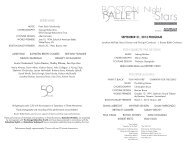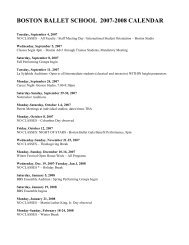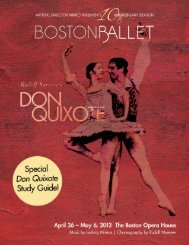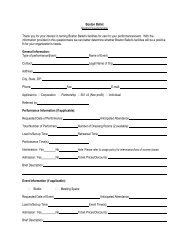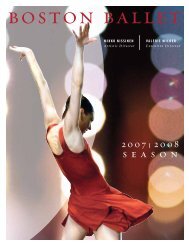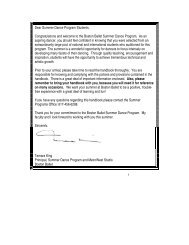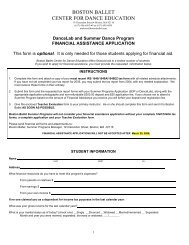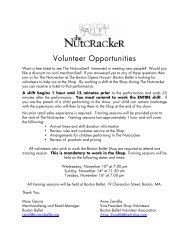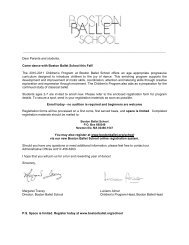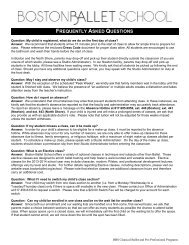Lorna Feijóo and Gabor Kapin by Gene Schiavone ... - Boston Ballet
Lorna Feijóo and Gabor Kapin by Gene Schiavone ... - Boston Ballet
Lorna Feijóo and Gabor Kapin by Gene Schiavone ... - Boston Ballet
Create successful ePaper yourself
Turn your PDF publications into a flip-book with our unique Google optimized e-Paper software.
<strong>Lorna</strong> Feijóo <strong>and</strong> <strong>Gabor</strong> <strong>Kapin</strong> <strong>by</strong> <strong>Gene</strong> <strong>Schiavone</strong>; Kelley Potter <strong>by</strong> John RuttenbergChoreography <strong>by</strong> George Balanchine ©The George Balanchine Trust.
SynopsisPhotos of <strong>Lorna</strong> Feijóo <strong>and</strong> <strong>Boston</strong> <strong>Ballet</strong> dancers <strong>by</strong> <strong>Gene</strong> <strong>Schiavone</strong>Act IA forest near the palace of Theseus, a duke, one Midsummer EveThe curtain rises on the court of Oberon <strong>and</strong> Titania, King <strong>and</strong> Queen of the fairies. Surrounded <strong>by</strong> their followers of bugs<strong>and</strong> butterflies, Oberon dem<strong>and</strong>s that Titania relinquish a small child, a ‘changeling’, to be his servant. Titania refuses,sending Oberon into an outrage at her disobedience. Oberon orders Puck, a hobgoblin of the forest, to seek a magicalflower pierced <strong>by</strong> Cupid’s arrow that will cause anyone under its influence to fall in love with the first person the eyes behold.While Titania is asleep, the flower’s spell is cast over her.Meanwhile, Helena, an Athenian beauty, w<strong>and</strong>ers in the woods to meet Demetrius, whom she loves but who does not loveher. Demetrius promptly rejects her <strong>and</strong> goes searching for Hermia. In a moment of sympathy for Helena, Oberon watches<strong>and</strong> tells Puck to use the flower on Demetrius so that he may return Helena’s affection.A second couple, Hermia <strong>and</strong> Lys<strong>and</strong>er, who are very much in love, are also w<strong>and</strong>ering in the forest. They become separated<strong>and</strong> Demetrius seizes the opportunity to pursue Hermia. Puck, eager to carry out Oberon’s orders, mistakenly anointsLys<strong>and</strong>er with the flower. Helena appears <strong>and</strong> Lys<strong>and</strong>er, under the flower’s spell, instantly falls in love with Helena!Hermia returns <strong>and</strong> is astonished <strong>and</strong> then dismayed to see Lys<strong>and</strong>er’s new devotion to Helena. Puck manages to cast theflower’s spell on Demetrius, as well, who now also bestows his affections on Helena. This is much to the delight of Helena,who began the story without anyone’s affection <strong>and</strong> now has the attentions of two men. Demetrius <strong>and</strong> Lys<strong>and</strong>er, now bothin love with Helena, begin to quarrel over her.Enter Bottom <strong>and</strong> his companions, rustic craftsmen of the mortal world. Upon Oberon’s orders, Puck separates Bottom fromhis companions <strong>and</strong> transforms his head into that of a donkey <strong>and</strong> places him at the sleeping Titania’s feet. Awakening,Titania sees Bottom first, <strong>and</strong> falls in love with him. At last Oberon, his anger over, has Bottom sent away <strong>and</strong> releasesTitania from her spell.Hermia now gets no attention, Helena too much. The men, completely at odds, begin to fight. Puck, <strong>by</strong> his magic, causesthem to separate, lose one another <strong>and</strong> w<strong>and</strong>er apart in the forest until, exhausted, they fall asleep. The spells removed,Puck arranges for Helena to fall asleep beside Demetrius <strong>and</strong> Lys<strong>and</strong>er <strong>by</strong> Hermia.Theseus <strong>and</strong> Hippolyta discover the lovers asleep in the forest <strong>and</strong> awaken them. They find the lovers’ differences resolved,<strong>and</strong> proclaim a triple wedding for themselves <strong>and</strong> the two couples.Act IIThe Palace of TheseusAct II begins with parades, dancing, <strong>and</strong> divertissements in honor of the newly married couples. When the celebrationsare over <strong>and</strong> the mortals retire, we return to the domain of Oberon <strong>and</strong> Titania, who are now reunited <strong>and</strong> at peace.Puck, having put order into disorder, sweeps away the remnants of the night’s doings. The fireflies twinkle in the night <strong>and</strong>reclaim the forest.
the LEADING CharactersOberon – King of the FairiesOberon wears a rich blue tunicTitania – Queen of the FairiesTitania wears long, flowing dresses in pale pinks <strong>and</strong> yellowsPuck – A magical hobgoblin of the forest <strong>and</strong> Oberon’s spritely,mischievous servantHelena – in love with DemetriusHelena wears redDemetrius – first in love with Hermia, <strong>and</strong> after Puck’s spell, with Helena, but isreunited with HermiaDemetrius wears redHermia – in love with Lys<strong>and</strong>erHermia wears blueLys<strong>and</strong>er – first in love with Hermia, <strong>and</strong> after the Puck’s spell, with HelenaLys<strong>and</strong>er wears blueBottom – a jovial craftsman who loves to performBottom becomes a donkey through Oberon’s trickeryTheseus – Duke of AthensTheseus wears regal black <strong>and</strong> metallic fabricsHippolyta – Queen of the Amazons <strong>and</strong> soon to be wife of TheseusHippolyta wears a black <strong>and</strong> gold costume with gold jewelry <strong>and</strong> headpiece
George Balanchine, ChoreographerJanuary 22, 1904 – April 30th, 1983About the PRODUCTIONBorn in St. Petersburg, Russia, George Balanchine is regarded as the foremost contemporarychoreographer in the world of ballet. He came to the United States in late 1933, at the age of29, accepting the invitation of the young American arts patron Lincoln Kirstein, whose dreamincluded the creation of a ballet company in America. At Balanchine’s request, Kirstein alsosupported the formation of the School of American <strong>Ballet</strong>, founded in 1934. Eventually, with apremiere performance in 1948, the New York City <strong>Ballet</strong> was born. Balanchine would serveas ballet master <strong>and</strong> principal choreographer until his death in 1983 creating some 400dance works during his lifetime. The thrust of Balanchine’s life was to look toward the futurewhile honoring the best accomplishments of the past. His choreographic works exp<strong>and</strong>ed theboundaries of classical dance <strong>and</strong> while his style initially seemed well-suited to the energy<strong>and</strong> speed of American dancers, his ballets are now performed <strong>by</strong> all the major classicalballet companies throughout the world.Balanchine <strong>and</strong> A Midsummer Night’s DreamWhen George Balanchine was eight years old, he played an elf in a production of William Shakespeare’s A MidsummerNight’s Dream in St. Petersburg. The play became one of his favorites, <strong>and</strong> decades later he could still recite lines from itin Russian. A half century after he appeared in the play, Balanchine presented his own version of A Midsummer Night’sDream, one of only a few full-length ballets. The world premiere, on January 17, 1962, was danced <strong>by</strong> New York City<strong>Ballet</strong> (NYCB) <strong>and</strong> featured Edward Villella as Oberon, Melissa Hayden as Titania, <strong>and</strong> Arthur Mitchell as Puck.Costumes <strong>and</strong> Set DesignCostume <strong>and</strong> set design for this production of A Midsummer Night’s Dream were created <strong>by</strong> Luisa Spinatelli, prominentartist for The Teatro alla Scala in Milan, Italy. The Teatro alla Scala, opened on August 3rd, 1778 <strong>and</strong> has since seenmany of the world’s finest artists grace its stage during the past 200 years. The theater continues to be recognized asone of the leading opera <strong>and</strong> ballet theatres in the world.The scenic design for this production of A Midsummer Night’s Dream provides the backdrop for Shakespeare <strong>and</strong>Balanchine’s dream world. The production was shipped in four large sea containers <strong>and</strong> traveled over the Atlantic fromThe Teatro alla Scala in Milan.During the arrival of Theseus <strong>and</strong> Hippolyta at the end of Act I, the royal couple <strong>and</strong> their hounds enter in a haze ofcloud <strong>and</strong> mist. Stageh<strong>and</strong>s will use one-hundred pounds of dry ice per performance to create this effect. At the close ofthe ballet, Puck reminds us all that we have been merely watching a dream before he takes flight. The flying contraptionfor this performance is built especially for The <strong>Boston</strong> Opera House. See if you can tell how Puck flies from the stage.
About the ComposerJakob Ludwig Felix Mendelssohn BartholdyFebruary 3, 1809—November 4, 1847Felix Mendelssohn was born in Hamburg, on February 3rd, 1809. Mendelssohn began his musical journey at an earlyage with musical instruction from his sister Fanny. Felix Mendelssohn began to emerge as a true child prodigy, beinggifted in many languages <strong>and</strong> painting <strong>and</strong> playing both the piano <strong>and</strong> the violin.Mendelssohn found inspiration in the works of English playwright William Shakespeare. At the age of seventeen, hecomposed the overture to A Midsummer Night’s Dream Opus 21, based on the Bard’s comedic play, a favorite of his<strong>and</strong> his sister Fanny.From 1826 to 1829, Mendelssohn studied music as his chosen profession at Berlin University <strong>and</strong> during the followingyears, Mendelssohn traveled <strong>and</strong> performed all over Europe, including Engl<strong>and</strong>, Scotl<strong>and</strong>, Italy <strong>and</strong> France wherehe was well loved <strong>by</strong> audiences, ultimately taking the position of conductor at Düsseldorf, Germany. At the age of 26,Mendelssohn continued along his journey to become the conductor of the Leipzig Gew<strong>and</strong>haus Orchestra. In 1832,Mendelssohn married Cecile Jeanrenaud, leading to a happy marriage <strong>and</strong> five children.Mendelssohn’s prolific career continued over the years that followed through numerous compositions, successful performancesof his work <strong>and</strong> those of other great composers. In 1842, only a few years before his death, Mendelssohnwould return to Shakespeare’s inspiration when he composed additional music for a play production of A MidsummerNight’s Dream.Some sounds to listen for:• Listen for the sounds of the bassoons as Bottom <strong>and</strong> his friends enter atthe end of the Intermezzo.• Listen for the twittering flutes <strong>and</strong> strings at the conclusion of the weddingmarch suggesting the fairies’ part in the matchmaking.• Listen for the four chords that start the Overture at the very end of the Finale.Did you know?Did you know?Spinatelli creates detail <strong>and</strong> texture through her sumptuous headpieces. She primarily utilizes sequins instead of gems <strong>and</strong>stones because it makes the headpiece lighter <strong>and</strong> less expensive to produce. Look closely. Can you tell a difference?Did you know?A professional sword-master worked with the men dancing the roles of Lys<strong>and</strong>er <strong>and</strong> Demetrius to teach them basicsword skills <strong>and</strong> safety. Just as in dance, the sword fight is choreographed <strong>and</strong> the basics of swordplay are essential totheir roles.Created <strong>by</strong> Brynn E. Wartman, <strong>Boston</strong> <strong>Ballet</strong> Education & Community Outreach, March, 2011
Resources for the Midsummer Study Guide:The George Balanchine Foundationhttp://www.balanchine.org/balanchine/01/index.htmlNew York City <strong>Ballet</strong>http://www.nycballet.com/nycb/content/visitors.aspx?ID=463The Kennedy Centerhttp://www.kennedy-center.org/calendar/?fuseaction=composition&composition_id=2675Buckle, Richard (1998). George Balanchine: <strong>Ballet</strong> Master. New York: R<strong>and</strong>om House, Inc.<strong>Ballet</strong> Met, Columbushttp://www.balletmet.org/Notes/Midsummer.htmlTodd, R. Larry (2003). Mendelssohn - A Life in Music. Oxford; New York: Oxford University Press.Article: Balanchine's Dream By Sheryl Flatow



